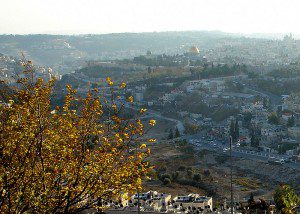
(Click to enlarge.)
John 5:1 is so short that I’ll just give you the full text here, in both English and Greek:
“After this there was a feast of the Jews; and Jesus went up to Jerusalem.”
Μετὰ ταῦτα ἦν ἑορτὴ τῶν Ἰουδαίων, καὶ ἀνέβη Ἰησοῦς εἰς Ἱεροσόλυμα.
I want to concentrate, simply, on the idea of “going up” to Jerusalem.
The city of Jerusalem is situated on a relatively high mountain ridge, with the Mediterranean coast to the west and the even-deeper Jordan River Valley to the east.
Thus, when “a certain man went down from Jerusalem to Jericho and fell among thieves” (after which he was cared for by a “Good Samaritan”), he was really going down. And anybody who’s ever driven the road from Jericho to Jerusalem knows how steep the grade is upwards.
1 Nephi gets it exactly right when — clever boy, that Joseph Smith! — Lehi and the members of his family consistently go down from Jerusalem into the wilderness and then return up to Jerusalem when they’re sent back.
But it’s even more than that. Jerusalem is the site of the temple of God, the mountain of the Lord. So the pilgrim psalms in the Bible are “songs of ascent.”
And, even today, Jews who immigrate to Israel are said to be “making aliyah,” where aliyah means ascent. (Think of the Israeli national airline, El Al, the name of which means “to the skies,” or “skywards.”)
In modern temples, too, worshipers climb up ever higher in the building as they perform temple ordinances.
This is a very rich and very ancient idea.












